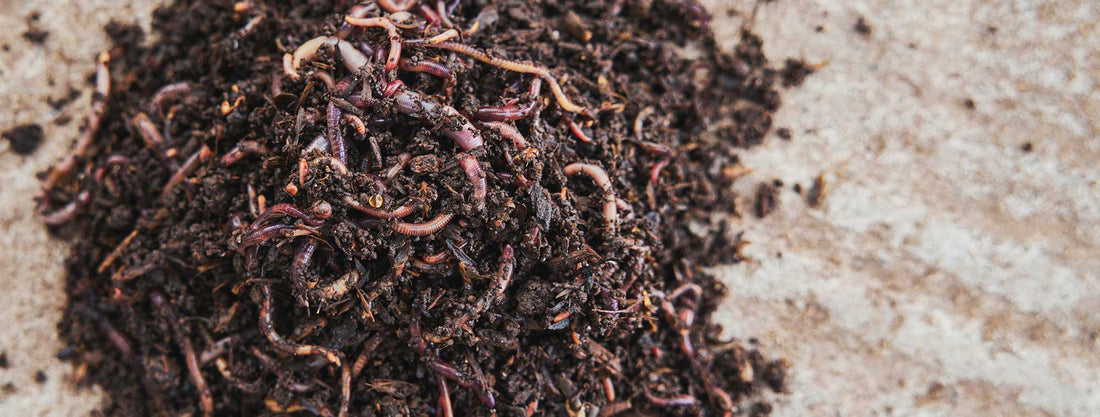In this article, you will discover everything you’ve ever wanted to know about earthworms, particularly about compost worms (Eisenia fetida), a species within the earthworm family.
Characteristics
- Earthworms are the largest soil invertebrates.
- The compost worm reaches a body length of 6-13 cm and is 3-4 mm thick.
- There are approximately 3,000 species of earthworms worldwide; about 40 of these live in Switzerland.
- The Australian earthworm (Megascolides australis) can reach a body length of about 2 meters and can be 2.5 cm thick.
- The compost worm is reddish with yellowish bands, distinguishing it clearly from other species.
- All worms breathe through their skin.
- Earthworms can survive in water, provided it contains enough oxygen.
- Earthworms have 5 pairs of "hearts."
- Worms have tiny bristles on their skin that help them move.
- Earthworms do not have eyes, ears, or a nose. They possess sensitive light sensory cells, a sense of touch and gravity, and a very good sense of taste.
- Earthworms cannot tolerate sunlight: Ultraviolet sunlight causes respiratory distress in these lightly colored animals the next day and leads to death after a state of paralysis.
- The earthworm is one of the few living beings that can form the valuable clay-humus complexes important for soil fertility.
- Worm castings contain on average five times more nitrogen, seven times more phosphorus, and eleven times more potassium than the surrounding soil.
- 1 ha of pasture can feed a cow (0.5 t); underground, it's 4 cows (3-4 t) in the form of soil organisms, of which up to two cows (1 t) are earthworms.
- On a pasture, 3 t of earthworms produce up to 600 t of worm castings per ha per year.
- Earthworms are tunnel builders: 200 g of earthworms create a tunnel system with a maximum extension of 900 m in one cubic meter. That's 9,000 km per hectare.
- Relative to their body size, earthworms are one of the strongest living beings: They can lift 50 to 60 times their own body weight (1323 g/cm2; in comparison, humans: 200 g/cm2).
- Earthworms have calcium glands: They can absorb calcium compounds from their food and counteract acidification by binding excess CO2 with dissolved lime and excreting it as calcium carbonate.
- Worms consist of up to 70% protein and are therefore a popular prey.
- The earthworm was called "reger Wurm" (active worm) in the 17th century, likely because the worms come to the surface when it rains (presumably to access oxygen).
Life Cycle
- Some worm species can live up to 8 years, but the average lifespan is 2 years.
- Earthworms are hermaphrodites, having both reproductive organs. However, they do not fertilize themselves; it requires two worms.
- Earthworms mainly reproduce in spring and autumn when soil temperature and moisture.
- Sexual maturity is indicated by the saddle in the front third of the worm. From this point, one can distinguish the front and back: The saddle is located at the head end.
- After mating, the saddle moves to the front end, and the worm pulls itself out of it. In this process, the eggs are laid and fertilized. The shed saddle becomes a lemon-shaped cocoon. A cocoon contains 8-20 eggs, from which about 2 hatch.
- The compost worm hatches at 25°C after 16 days and is sexually mature after another 9 weeks, while the dew worm takes up to 135 days to hatch at 12°C.
Behavior
- Compost worms eat up to half their own weight per day.
- Worms have no teeth: They ingest material and metabolize the carbohydrates and proteins of dead plant residues and the microorganisms living on them; Decomposition occurs through the microorganisms in the worms and through mineral particles as milling stones.
- In danger, the compost worm secretes a foul-smelling yellow fluid from its back pores to protect itself from predators; hence the species name foetida (stinking).
- In an emergency, the worm has the ability to sever its hind end (up to 50 segments, the worm has up to 200 segments, the compost worm 105 segments), for example, if a bird tries to pull the worm by the hind end out of its living tube in the ground. Parts of the segments can regrow. This behavior has also been observed in cases of strong acidification.

